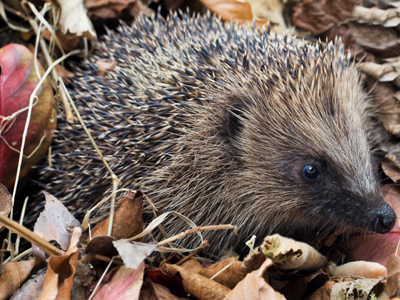
Hedgehogs are nocturnal and hibernate during the winter.
Adaptation of Animals and Plants 01
Revise what you know about Charles Darwin and evolution. What is survival of the fittest?
Studying in years 7, 8 or 9? Enjoy learning by playing quizzes.
Scroll down to play the quiz
1 .
Hedgehogs are nocturnal and hibernate during the winter. Which of the following is NOT true?
Hedgehogs eat insects and worms - they are herbivores
Their metabolic rate drops in winter
They are nocturnal as many insects are active at night
They hibernate as food is scarce in winter
They are omnivores, they will eat plants as well as insects and worms. Some people feed hedghogs in their gardens by leaving bread and milk for them. That is a very bad thing to do as they are not adapted to digest these and the milk can give them diarrhoea. That leads to dehydration and loss of essential vitamins and minerals, which weakens them. If you really want to feed them, you can buy special hedgehog food, or give them meat or vegetable based foods e.g. tinned cat food (but NOT fish flavours)
2 .
A polar bear is adapted to live in the arctic. Which of the following is NOT true?
They have a thick layer of fat for insulation
They have big feet to produce high pressure on the snow
They have waterproof fur for insulation when in water
Their fur looks white to blend in with their surroundings
Big feet produce low pressure so they don't sink in the snow
3 .
Desert tortoises are adapted to live in the desert. Which of the following is NOT true?
The adults can survive about a year with no water
The hard shell can't protect them
They burrow to protect themselves from the extreme heat
They dig shallow pits to catch water
The shell is an adaptation that does protect them
4 .
A camel is adapted to survive in desert conditions. Which of the following is NOT true?
The hump is used to store fat
The nostrils can close to keep sand out
They have large feet so they do not sink in soft sand
They have long eyelashes to attract other camels
The eyelashes keep sand out of their eyes
5 .
A cactus is adapted to survive in desert conditions. Which of the following is NOT true?
Flowers only open during the heat of the day
The leaves are spines to prevent water loss
The leaves are spines to stop animals eating them
The swollen stem stores water
The flowers open in the cooler evening/night as that is when the pollinating insects are flying
6 .
The area in which an organism lives is called .......
A habitat
A river
A wood
An environment
A river and a wood are types of habitat
7 .
Giraffes are adapted to live on the African savanna. Which of the following is NOT true?
They are tall so that it is easy to spot predators
They can drink up to 12 gallons of water when available
They have a long neck to eat leaves from tree tops
They have a tiny heart to pump blood up their necks
They have an extra large heart
8 .
An arctic poppy is adapted to live in the arctic tundra. Which of the following is NOT true?
The flower moves during the day to face the sun
The stems and leaves are hairy to prevent water loss
They grow near to the ground to protect against winds
They have shallow roots as the top layer of soil is always frozen
The top layer of soil thaws out during the arctic summer
9 .
An oak tree is adapted to grow in a wood. Which of the following is NOT true?
It has a large root system to absorb water and minerals
It has a large root system to anchor the tree
It has plenty of leaves to absorb sunlight
It loses its leaves in autumn to save food
It loses its leaves in autumn to save water
10 .
Penguins are adapted to live in the Antarctic. Which of the following is NOT true?
The dark coloured feathers reflect heat from the sun
Their webbed feet make them powerful swimmers
They have overlapping feathers to waterproof them
They have thick skin and lots of fat to keep them warm
The dark coloured feathers absorb heat from the sun
**Unlimited Quizzes Await You! 🚀**
Hey there, quiz champ! 🌟 You've already tackled today's free questions.
Ready for more?
Ready for more?
🔓 Unlock UNLIMITED Quizzes and challenge yourself every day. But that's
not all...
not all...
🔥 As a Subscriber you can join our thrilling "Daily Streak" against other
quizzers. Try to win a coveted spot on our Hall of Fame Page.
quizzers. Try to win a coveted spot on our Hall of Fame Page.
Don't miss out! Join us now and keep the fun rolling. 🎉
**Unlimited Quizzes Await You! 🚀**
Hey there, quiz champ! 🌟 You've already tackled today's free questions. Ready for more?
🔓 Unlock UNLIMITED Quizzes and challenge yourself every day. But that's not all...
🔥 As a Subscriber you can join our thrilling "Daily Streak" against other quizzers. Try to win a coveted spot on our Hall of Fame Page.
Don't miss out! Join us now and keep the fun rolling. 🎉







